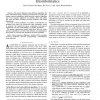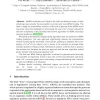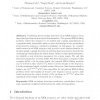282 search results - page 45 / 57 » On predicting secondary structure transition |
ISMB
1994
13 years 9 months ago
1994
Weconsider the problem of parsing a sequence into different classes of subsequences.Twocommonexamplesare finding the exons and introns in genomicsequences and identifying the seco...
TCBB
2010
13 years 6 months ago
2010
— We present efficient cache-oblivious algorithms for some well-studied string problems in bioinformatics including the longest common subsequence, global pairwise sequence alig...
RECOMB
2006
Springer
14 years 7 months ago
2006
Springer
mRNA molecules are folded in the cells and therefore many of their substrings may actually be inaccessible to protein and microRNA binding. The need to apply an accessability crite...
WABI
2007
Springer
14 years 1 months ago
2007
Springer
Predicting the secondary structure of an RNA sequence is an important problem in structural bioinformatics. The general RNA folding problem, where the sequence to be folded may con...
JCB
2006
13 years 7 months ago
2006
Protein fold recognition is an important step towards understanding protein three-dimensional structures and their functions. A conditional graphical model, i.e., segmentation con...



